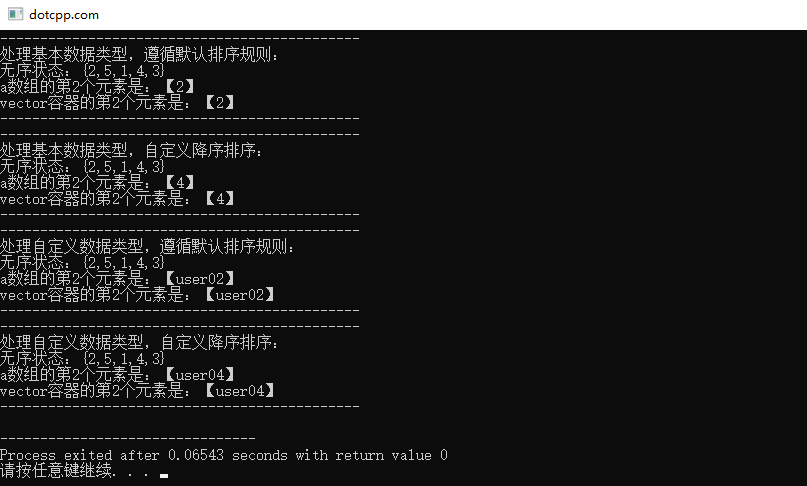nth_element(beg , pos , end)排序算法模板函数,”nth“意为”第几个“,该排序算法指的是在指定区间[beg , end)按排序规则找出位置在pos上的元素是谁并进行填充,此函数会打乱原有序列。
使用nth_element(beg , pos , end)时需要包含头文件<algorithm>。
使用nth_element(beg , pos , end)函数进行排序也有以下三点要求:
1. 由于nth_element(beg , pos , end)对容器进行排序时,需要对元素进行随机访问,所以要求排序容器为随机访问迭代器,也就是array容器、vector容器、deque容器,C风格数组(将指针作迭代器使用)。
2. 如果元素为自定义数据,由于nth_element(beg , pos , end)默认是升序排序,所以要求自定义数据重载“<”比较运算符。
3. 如果元素为自定义数据,由于nth_element(beg , pos , end)需要对元素进行高效移动,所以需要自定义数据提供移动构造函数和移动赋值运算符。
nth_element(beg , pos, end)排序有两个重载函数,下面我们通过代码向读者简要展示其参数和功能:
/*此处beg意为排序的起始范围,pos意为求取排序后元素的位置(基于0-based),end意为排序的终止范围,三者皆可为数组指针或迭代器*/ nth_element(beg , pos , end);//默认是升序排序 nth_element(beg , pos , end , cmp());//额外增加仿函数cmp进行自定义比较
我们通过nth_element(beg , pos, end)分别求出普通数组和vector容器的第三个元素:
#include<iostream>
#include<vector>
#include<string>
#include<iterator> //使用迭代器函数进行切割,复习前面知识 next(it,n)
#include<algorithm>//包含算法头文件!
/* nth_element(beg , pos , end)分别求出普通数组和vector容器排序后的第二个元素 */
using namespace std;
/*自定义数据*/
struct dotcpp_user
{
bool operator<(const dotcpp_user&u)const
{
return grade<u.grade;
}
string name;//姓名
int age;//年龄
int grade;//做题个数
bool is_online;//是否在线
};
/*基础数据类型仿函数*/
struct cmp_basic
{
bool operator()(const int &a,const int &b)const
{
return a>b;
}
};
/*自定义数据类型仿函数*/
struct cmp_diy
{
bool operator()(const dotcpp_user &u1,const dotcpp_user &u2)const
{
return u1.grade>u2.grade;
}
};
/*--基本数据类型&&默认升序排序--*/
void test1()
{
cout << "---------------------------------------------\n" ;
cout<< "处理基本数据类型,遵循默认排序规则:\n";
cout << "无序状态:{2,5,1,4,3}\n" ;
int a[]={2,5,1,4,3};
nth_element(&a[0],&a[1],&a[4]+1);
vector<int> v{2,5,1,4,3};
nth_element(v.begin(),next(v.begin(),1),v.end());
cout << "a数组的第2个元素是:【"<<a[1]<< "】\n";
cout << "vector容器的第2个元素是:【"<< *next(v.begin(),1)<< "】\n";
cout << "---------------------------------------------\n" ;
}
/*--基本数据类型&&自定义降序排序--*/
void test2()
{
cout << "---------------------------------------------\n" ;
cout<< "处理基本数据类型,自定义降序排序:\n";
cout << "无序状态:{2,5,1,4,3}\n" ;
int a[]={2,5,1,4,3};
nth_element(&a[0],&a[1],&a[4]+1,cmp_basic());
vector<int> v{2,5,1,4,3};
nth_element(v.begin(),next(v.begin(),1),v.end(),cmp_basic());
cout << "a数组的第2个元素是:【"<<a[1]<< "】\n";
cout << "vector容器的第2个元素是:【"<< *next(v.begin(),1)<< "】\n";
cout << "---------------------------------------------\n" ;
}
/*--自定义数据类型&&默认升序排序--*/
void test3()
{
cout << "---------------------------------------------\n" ;
cout<< "处理自定义数据类型,遵循默认排序规则:\n";
cout << "无序状态:{2,5,1,4,3}\n" ;
/*创建复杂对象*/
dotcpp_user u1{"user01",18,100,true};
dotcpp_user u2{"user02",18,200,true};
dotcpp_user u3{"user03",18,300,true};
dotcpp_user u4{"user04",18,400,true};
dotcpp_user u5{"user05",18,500,true};
dotcpp_user a[]={u2,u5,u1,u4,u3};
nth_element(&a[0],&a[1],&a[4]+1);
vector<dotcpp_user> v{u2,u5,u1,u4,u3};
nth_element(v.begin(),next(v.begin(),1),v.end());
cout << "a数组的第2个元素是:【"<<a[1].name<< "】\n";
cout << "vector容器的第2个元素是:【"<< next(v.begin(),1)->name<< "】\n";
cout << "---------------------------------------------\n" ;
}
/*--自定义数据类型&&自定义降序排序--*/
void test4()
{
cout << "---------------------------------------------\n" ;
cout<< "处理自定义数据类型,自定义降序排序:\n";
cout << "无序状态:{2,5,1,4,3}\n" ;
/*创建复杂对象*/
dotcpp_user u1{"user01",18,100,true};
dotcpp_user u2{"user02",18,200,true};
dotcpp_user u3{"user03",18,300,true};
dotcpp_user u4{"user04",18,400,true};
dotcpp_user u5{"user05",18,500,true};
dotcpp_user a[]={u2,u5,u1,u4,u3};
nth_element(&a[0],&a[1],&a[4]+1,cmp_diy());
vector<dotcpp_user> v{u2,u5,u1,u4,u3};
nth_element(v.begin(),next(v.begin(),1),v.end(),cmp_diy());
cout << "a数组的第2个元素是:【"<<a[1].name<< "】\n";
cout << "vector容器的第2个元素是:【"<< next(v.begin(),1)->name<< "】\n";
cout << "---------------------------------------------\n" ;
}
int main(){
system("title dotcpp.com");
test1();
test2();
test3();
test4();
return 0;
}编译结果如下:

观察输出结果,升序排序下,第二个元素是2;降序排序下,第二个元素是4,完全符合预给指令。
总结:对于nth_element(beg , pos, end),理解它的功能最重要。该函数模板的功能是在指定区间[beg , end)按排序规则找出位置在pos上的元素是谁并进行填充,此函数会打乱原有序列,该类排序算法主要运用于求取中位数,分析数据的总体水平。
C语言网提供由在职研发工程师或ACM蓝桥杯竞赛优秀选手录制的视频教程,并配有习题和答疑,点击了解:
一点编程也不会写的:零基础C语言学练课程
解决困扰你多年的C语言疑难杂症特性的C语言进阶课程
从零到写出一个爬虫的Python编程课程
只会语法写不出代码?手把手带你写100个编程真题的编程百练课程
信息学奥赛或C++选手的 必学C++课程
蓝桥杯ACM、信息学奥赛的必学课程:算法竞赛课入门课程
手把手讲解近五年真题的蓝桥杯辅导课程